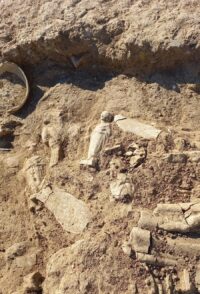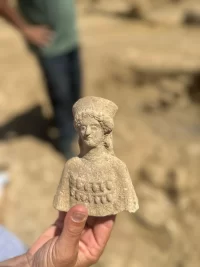 A rich votive deposit of dozens of statuettes, assorted fragments and human bones has been unearthed in the Valley of the Temples in Agrigento, Sicily. Archaeologists believe the deposit dates to the early 4th century B.C. when the city was putting itself back together after being sacked by Carthage.
A rich votive deposit of dozens of statuettes, assorted fragments and human bones has been unearthed in the Valley of the Temples in Agrigento, Sicily. Archaeologists believe the deposit dates to the early 4th century B.C. when the city was putting itself back together after being sacked by Carthage.
Founded as the Greek colony of Akragas, Agrigento was routed by the forces of Carthaginian general Himilko in 406 B.C. Agrigento’s residents fled to nearby Gela when Himilko sacked their city, but then he took Gela too. All of the Greek colonies on Sicily fell to Himilko and were made vassals of Carthage. Punic primacy would not last long, however. Timoleon of Corinth defeated Carthage in Sicily and liberated the Greek cities in 399 B.C.
 The votive deposit was discovered in an excavation of the northern hill of the 5th century B.C. Doric Temple of Juno in a room in the western section of an ancient housing complex dubbed House VIIb. The deposit was buried just above the 406 B.C. destruction level of the house. The positioning appears deliberate and likely held a ritual significance or symbolism.
The votive deposit was discovered in an excavation of the northern hill of the 5th century B.C. Doric Temple of Juno in a room in the western section of an ancient housing complex dubbed House VIIb. The deposit was buried just above the 406 B.C. destruction level of the house. The positioning appears deliberate and likely held a ritual significance or symbolism.
There are at least 60 elements in the deposit, including terracotta statuettes of deities, female busts, protomes (decorative reliefs from buildings), oil lamps, small vases and fragments of bronze artifacts. They were mixed with large numbers of bones and buried in one room of the complex. Archaeologists believe the deposit was made after the Akragantines returned to the city.  They collected artifacts and human remains left in fragments by the Carthaginian destruction and buried them all together in this room, perhaps because it had been dedicated to a particular cult purpose before the conquest.
They collected artifacts and human remains left in fragments by the Carthaginian destruction and buried them all together in this room, perhaps because it had been dedicated to a particular cult purpose before the conquest.
Archaeologists will continue to research the find, focusing on the complex stratigraphy connecting the deposit to the living layers and abandonment layers of the house. The recovered artifacts will be conserved and stabilized for eventual display.